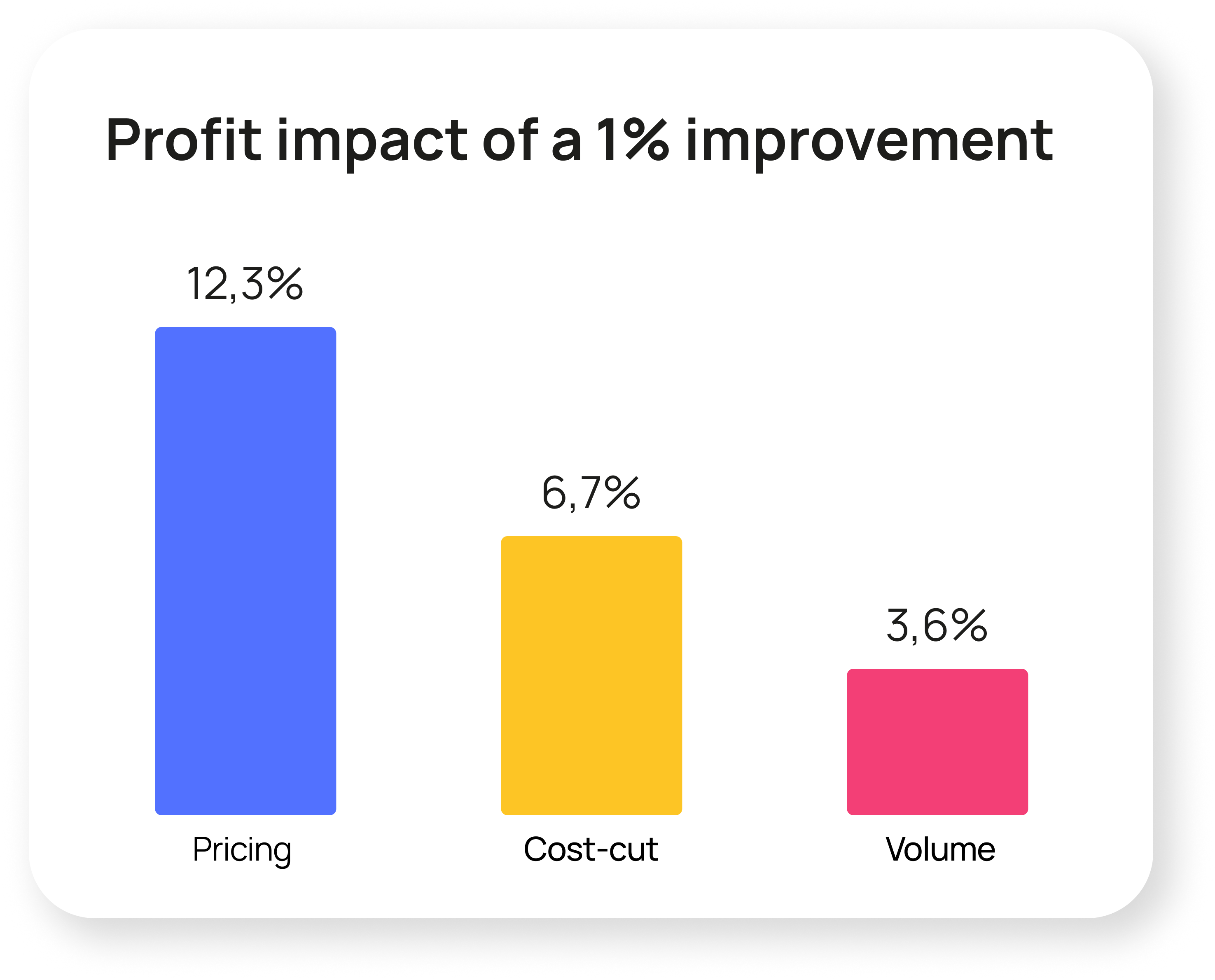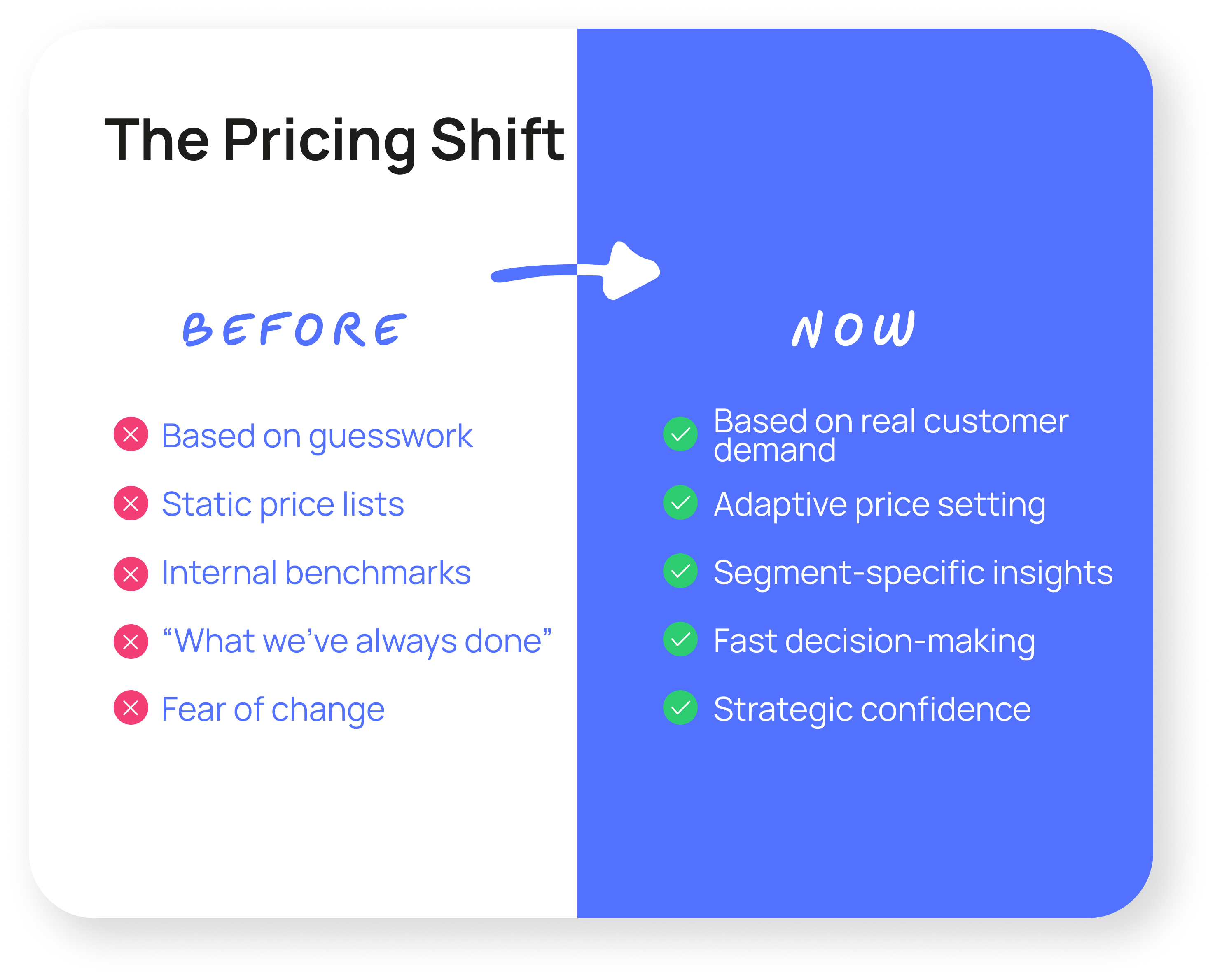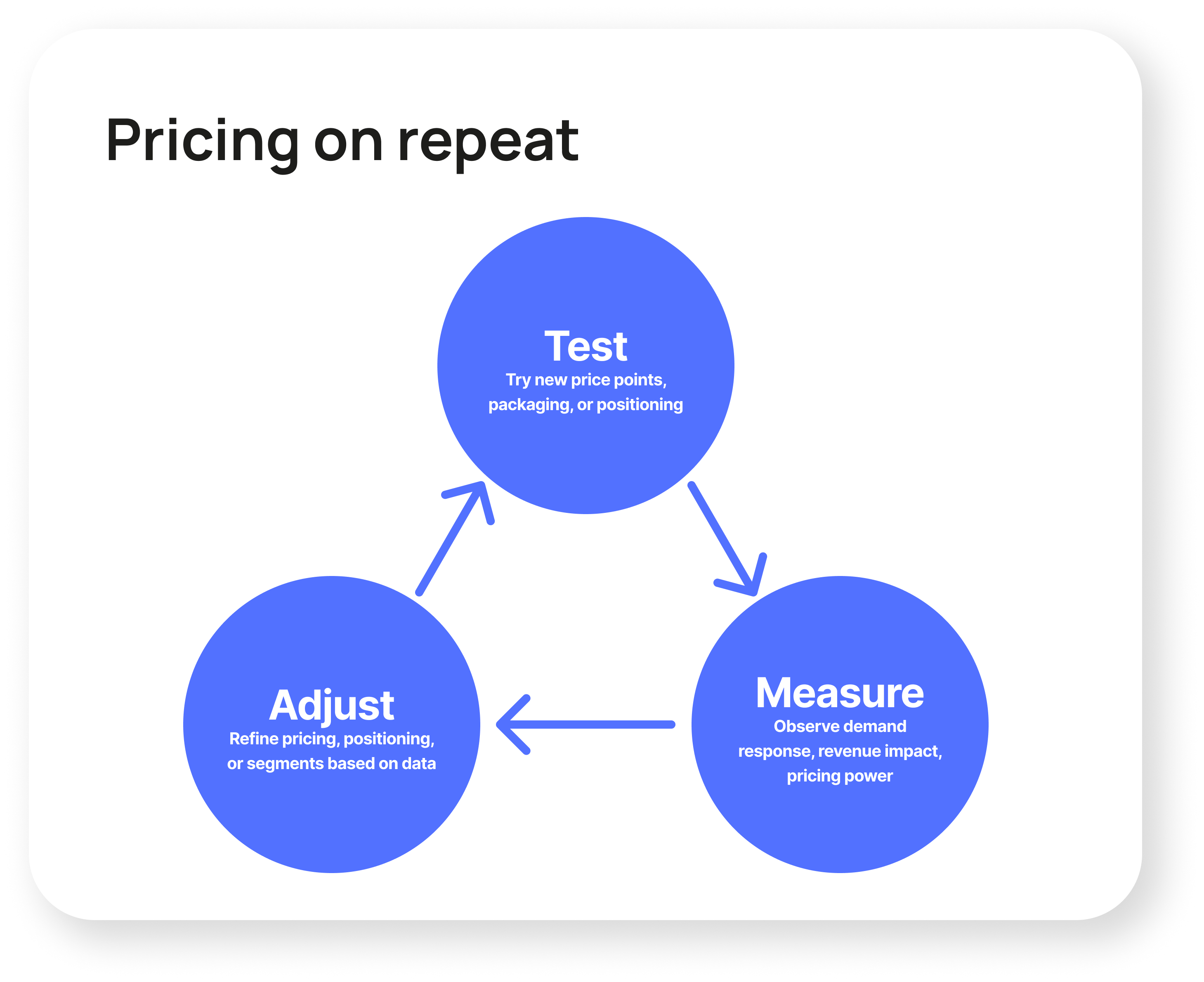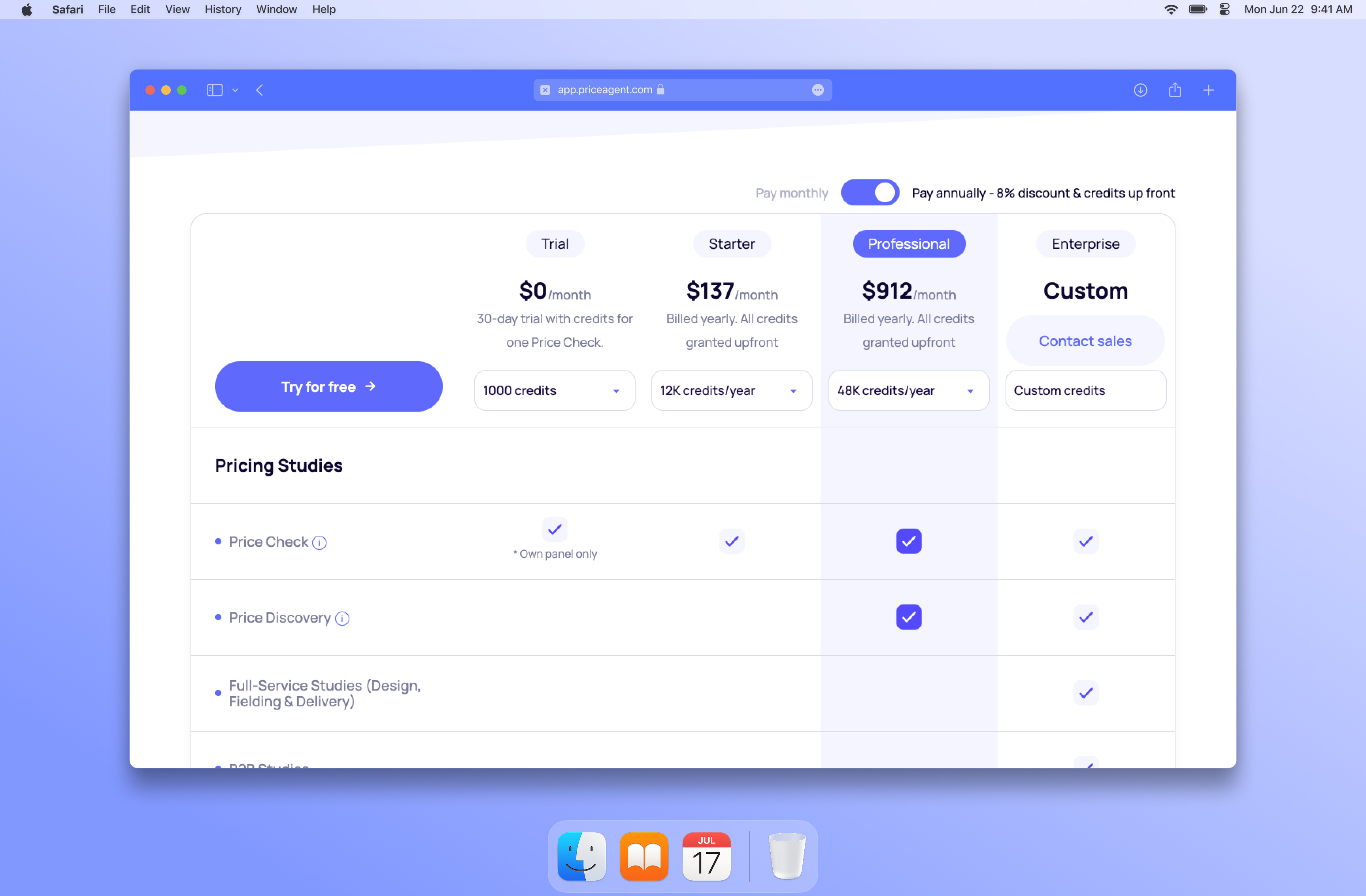Why cutting costs isn’t cutting it: The untapped power of pricing
Pricing, not cost-cutting, is the sharpest lever for profit growth.

Summarize article with AI
When businesses face pressure to “fix the numbers,” they often turn to the most visible lever; cost cutting. Headcount reductions, frozen budgets, postponed initiatives. It’s fast, measurable, and seemingly safe. But that instinct may be costing more than it saves.
Decades of research show that small, strategic improvements in pricing consistently outperform cost cuts when it comes to boosting profitability. In fact, price is often the most underused and misunderstood lever in the financial toolkit.
Pricing, not cost-cutting, is the sharper and more sustainable path to profit. We’ll explore why pricing changes deliver outsized returns, how cost reductions come with hidden consequences, and why companies need to reframe how they think about revenue versus efficiency.
Decades of research show that small, strategic improvements in pricing consistently outperform cost cuts when it comes to boosting profitability.
Profit leverage: Why pricing beats cost cutting
When it comes to improving profit margins, not all levers are created equal. Among pricing, cost-cutting, and increasing volume, pricing consistently delivers the highest return on effort.
According to McKinsey, a 1% increase in price, assuming constant volume, can lead to an 8% boost in operating profit. Deloitte reports even higher figures, estimating a 12.3% lift in profit from a 1% price rise. In contrast, a 1% cut in variable costs yields only about a 6.7% improvement, and a 1% increase in volume results in just 3.6%. Harvard Business Review cites similar ratios: pricing changes outperform cost or volume shifts by a factor of 2–4x when it comes to bottom-line impact.

Why is price so powerful? Because unlike cost reductions, price improvements fall straight to the bottom line. Raising your average selling price by even a small amount, without losing volume, means every extra dollar contributes directly to profit. Cost cuts, on the other hand, often involve trade-offs: service quality, long-term capability, or employee morale.
In short, if your goal is margin improvement, pricing is not just effective, it’s exponentially more effective than most operational efficiency efforts. Yet most companies default to cost-cutting because it feels tangible and controllable. The data suggests this is a missed opportunity.
The hidden costs of cutting too deep
While cost cuts offer immediate financial relief, they often carry long-term consequences that quietly erode company performance. What looks like efficiency on paper can introduce hidden costs that drag down productivity, morale, and future growth potential.
Studies show the ripple effects clearly. After layoffs, 74% of surviving employees report a drop in their own productivity, and 77% observe more frequent mistakes across teams. Morale plummets, trust erodes, and discretionary effort declines. None of which show up in the next quarter’s earnings, but all of which impact performance.

It’s not just anecdotal. A large-scale study of 21.981 workers found that common cost-cutting tactics, like wage freezes, reduced training, and increased workloads, violate what’s known as the “psychological contract” between employer and employee. This breach of trust leads to higher grievance rates, disengagement, and ultimately turnover, which introduces new costs in recruitment, onboarding, and lost expertise.
Worse, indiscriminate cuts often target the very functions that drive long-term value; R&D, customer service, and product development. When those capabilities are weakened, the ability to compete and grow takes a hit, even if the balance sheet looks leaner.
In short: cost-cutting might stabilize the P&L in the short term, but it often weakens the foundation the company needs to grow. Unlike pricing, which strengthens margins without subtracting capability, cuts can quietly undermine the organization’s future.
Why most companies underestimate pricing power
Despite its outsized impact on profit, pricing is often neglected, misunderstood, or managed with outdated methods. Many companies still rely on static price lists, internal benchmarks, or “what we’ve always done,” rather than data-driven analysis of what customers are actually willing to pay.

This underinvestment in pricing isn’t just a tactical oversight, it’s a strategic gap. McKinsey found that more than 30% of pricing decisions fail to capture revenue that customers were actually willing to pay, meaning companies routinely undervalue what they sell. Deloitte emphasizes that companies with strong pricing capabilities consistently outperform peers in margin performance and adaptability, gaining a sustained advantage. They estimate that structured pricing programs can unlock up to 3% of addressable revenue, delivering measurable gains without sacrificing capability.
So why the blind spot? Pricing feels risky. It’s visible to the customer, and changing it can spark fear, of backlash, churn, or loss of competitiveness. But the reality is that customers often tolerate small increases when value is clear, and even modest changes can have large financial effects. It’s the guesswork that creates risk, not the price change itself.
What’s needed is a mindset shift. Pricing isn’t a compliance function or an afterthought. It’s a strategic lever that should be optimized continuously, just like product, sales, or operations. Companies that treat it that way unlock a powerful source of growth, without needing to cut deeper elsewhere.
Price optimization isn’t just effective. It’s evolving.
Traditional pricing strategies often fall into two camps: gut feeling or overly complex modeling. One relies on internal heuristics (“this feels like the right price”), while the other involves spreadsheets, price elasticity curves, or consultants working on six-week timelines. Both are slow. Both miss the market.
But pricing doesn’t have to be that way anymore. Today’s approach is about speed, adaptability, and grounded decision-making. Instead of modeling based on old sales data, modern pricing focuses on real-time demand signals, how customers react to different price points before you make a move.
This is a fundamental shift. It turns pricing from a static decision into a feedback loop. You can test hypotheses, simulate trade-offs, and see where demand plateaus or collapses. You’re no longer guessing what people might pay. You’re measuring it, live.

Compared to cost-cutting, this method does something critical: it preserves capability. You’re not reducing resources to balance the books. You’re unlocking margin by finding where you’re undervaluing your offer. And compared to legacy pricing methods, it’s not theoretical or lagging. It’s responsive, tactical, and tied directly to customer behavior.
In an environment where uncertainty is high and pressure on margins is constant, that kind of clarity isn’t a nice-to-have. It’s a necessity.
Conclusion
When profit pressure mounts, it’s tempting to reach for the familiar tools, cutting costs, trimming headcount, freezing spend. But the data is clear: pricing is a far sharper lever. A small, strategic price increase can drive 2–4 times the profit impact of equivalent cost cuts, without the collateral damage to morale, productivity, or long-term capability.
Cost-cutting often brings hidden risks. It weakens the very teams and systems needed to grow. Pricing, on the other hand, strengthens the business by aligning value with revenue. And with modern tools and methods, companies no longer need to rely on guesswork or outdated models. Pricing can now be fast, adaptive, and grounded in actual customer behavior.
The takeaway? Stop treating pricing as a last resort. Start treating it as your first move. As margin matters more than ever, smart pricing isn’t just a financial tactic. It’s a competitive advantage.
Further reading
- The power of value-based pricing
Learn how to set prices based on what customers are actually willing to pay and why this method consistently outperforms cost-based pricing. - Your price is too low, and here’s how to find out
Find out how to detect price walls and demand plateaus using real customer data, so you can raise prices with confidence and precision. - Demystifying price elasticity: A practical guide
Understand how customers respond to price changes and how to use elasticity to optimize profit across different products or segments. - The role of psychological pricing
Explore how small tweaks in pricing presentation can shape perception, boost sales, and protect your margins.









